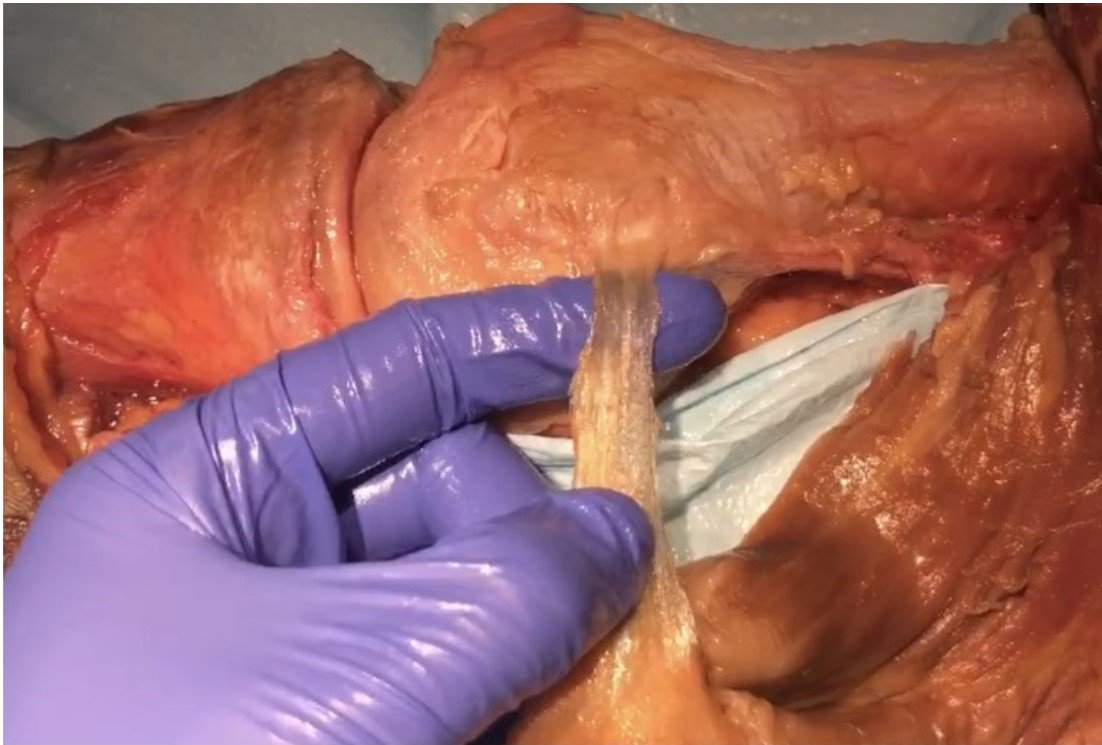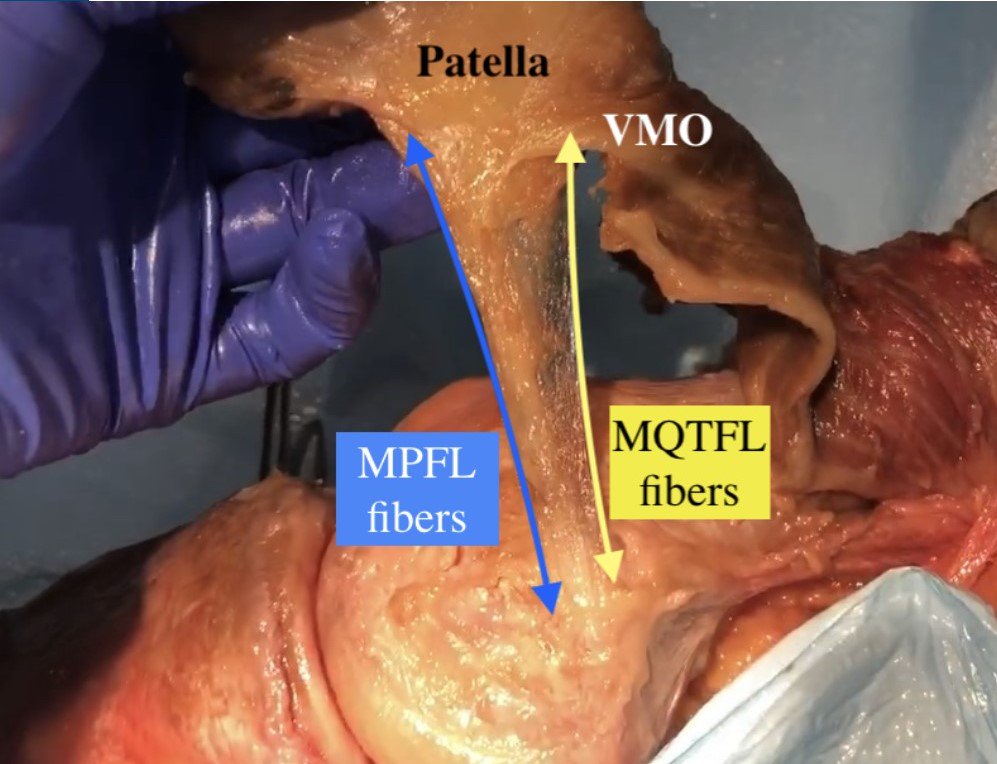BLOG: Elongated femoral footprint of the MPFL complex and implications for reconstruction
The literature for patellofemoral anatomy and surgery is evolving quickly.
Our understanding of the medial patellofemoral ligament and the importance of recreating its normal anatomy to minimize the risk of complications has continued to grow. More recent studies have highlighted the fibers that attach to the quadriceps tendon, now termed the medial quadriceps tendon femoral ligament (MQTFL), with new reconstruction techniques described to recreate these stabilizing fibers. To describe the combination of these fibers, the term medial patellofemoral complex (MPFC) has been proposed, as most knees have a combination of MPFL and MQTFL fibers, which have a common origin on the medial femur while demonstrating variability in their attachments to the patella and quadriceps tendon.

Multiple options now exist for reconstruction of this complex, including graft fixation on the patella, quadriceps tendon or both. Throughout these variations in reconstruction techniques, emphasis has remained on the importance of identifying the precise location of the femoral tunnel. We know from studies such as the one by Elias and Cosgarea that even 5 mm of femoral tunnel malpositioning can increase patellofemoral contact pressures, with the most common errors being too proximal or too anterior. Many of us employ radiographic tools intraoperatively to assess the position of the femoral tunnel, including the commonly cited “Schottle’s point.” Stephen and Amis have also radiographically described the native femoral attachment based on percentages of distance from the distal and posterior condyles, which helps account for differences in patient size.

The emphasis on identifying the appropriate “point” on the femur has focused on the midpoint of the MPFC footprint. However, the footprint itself is elongated and ribbon-shaped (Figure 1). Although prior studies have shown that the MPFL and MQTFL are indistinguishable at their femoral origin and constitute one single complex, we also know that the proximal fibers (MQTFL) originate at the proximal aspect of this footprint while the distal (MPFL) fibers originate distally (Figure 2), with almost 12-mm distance between the most proximal and distal margins. Understanding the relative relationship of the attachment points seems important for our ability to recreate these fibers. Instead of averaging their femoral attachment into a “midpoint,” should we be performing reconstruction of the specific fibers of the MPFL and/or MQTFL?
In my latest anatomic study, I sought to better understand the shape, position and orientation of the femoral MPFC footprint. In 17 cadaveric knees, the MPFC footprint was found to have a length of 11.7 mm±1.8 mm and a width of 1.7 mm±0.4 mm, indicating a “ribbon-like” shape of the femoral footprint, from which the fibers fan out to a broad attachment on the patella and/or quadriceps tendon. Furthermore, the long axis of the footprint was found to lie at an angle 14.6°±16.6° anterior to the axis of the femoral shaft, with the distal margin of the femoral MPFC footprint being 10.9 mm±1.7 mm distal and 2.6 mm±3.2 mm more posterior than the proximal margin.
When examining individual fibers, the most proximal (MQTFL) fibers were found to originate 7.4 mm±3.8 mm anterior and 1.8 mm±4.7 mm distal to the adductor tubercle, and 4.1 mm±2.9 mm posterior and 8.4 mm±5.6 mm proximal to the medial epicondyle. In contrast, the most distal (MPFL) fibers originated 4.9 mm±4.2 mm anterior and 12.7 mm±4.3 mm distal to the adductor tubercle, and 7.1 mm±2.4 mm posterior and 0.5 mm±5.6 mm distal to the medial epicondyle.

This study showed almost 12 mm in difference on the medial femur between the attachments of the most proximal and distal fibers, suggesting that varying functional properties likely exist between the fibers of the MPFC. Prior studies describing differences in the length of the fibers of the proximal vs. distal MPFC suggest varying isometric properties as well. While further studies are needed to evaluate the clinical significance of this with respect to patellar stabilization techniques and outcomes, biomechanical studies evaluating reconstruction techniques should consider the corresponding anatomical attachment points when comparing the function and efficacy of MPFL vs. MQTFL fibers in stabilizing the patella.
My current approach to MPFC reconstruction involves a “midpoint to midpoint” reconstruction, based on known descriptions of the femoral and anterior attachments of the complex. The growing emphasis on the differing functions between the MPFL and MQTFL fibers warrants greater attention to their respective attachment sites on the medial femur during future studies that investigate the efficacy and role of reconstruction of these specific fibers. Furthermore, this awareness of the differential anatomy between the most proximal and distal aspects of the femoral origin may be helpful in guiding the development of future reconstruction techniques that can allow for anatomic recreation of the entire footprint of the MPFC during the treatment of patellar instability.
References:
- Elias JJ, et al. Am J Sports Med. 2006;doi: 10.1177/0363546506287486.
- Fulkerson JP, et al. Arthrosc Tech. 2013;doi: 10.1016/j.eats.2013.01.002.
- Schottle PB, et al. Am J Sports Med. 2007; doi:10.1177/0363546506296415.
- Stephen JM, et al. Am J Sports Med. 2012; doi:10.1177/0363546512449998.
- Tanaka MJ. Arthroscopy. 2016;doi: 10.1016/j.arthro.2016.01.046.
- Tanaka MJ. Arthroscopy. 2020; doi:10.1016/j.arthro.2020.06.015.
- Tanaka MJ, et al. J Bone Joint Surg Am. 2016;doi: 10.2106/JBJS.15.01182.
- Tanaka MJ, et al. Knee Surg Sports Traumatol Arthrosc. 2019;doi: 10.1007/s00167-018-5266-y.
- Tanaka MJ, et al. Sports Med Arthrosc Rev. 2019;doi: 10.1097/JSA.0000000000000238.

